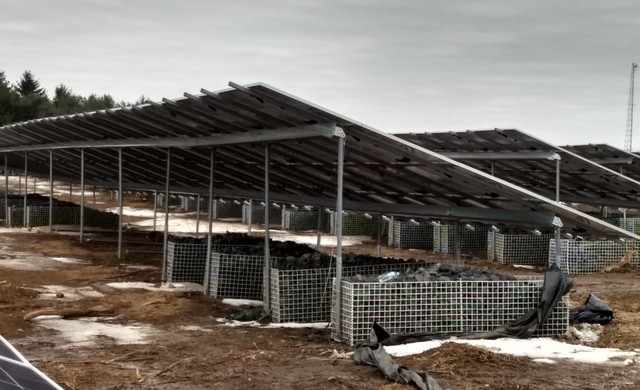Thank you so much for the input. I'm really glad to have advice from folks who have more experience and knowledge in this area.
@ABMax24, the pictures you provided are just the sort of ballast that my neighbor has for his very large solar array. I think it was done because the ground is rock here. The water table and frost are not issues in this area. There are flash floods, though, at times because when the "frog strangler" rains do come, the water can't soak into the hard ground, and it runs off.
@begreen, the article you linked is just what the owner of the company was proposing. He was very forthright that he has not used this technique before, but it was recommended to him by an engineer for our site, because it is very rocky and also not easy to access. There's no hope for a concrete truck. Pictures don't really capture it, but I took a few tonight just to give some idea. We would be glad not to have additional concrete poured into our ground and could get over the aesthetics of the ballast baskets for that reason. It was just such an unfamiliar idea to me that I wanted to see if anybody had more knowledge.
This is a view of the ground where the array would be placed. We could never use a bladed lawnmower down here (not that there's a lawn), but I have on occasion used a walk behind string trimmer to attack invasive species before they go to seed. Thankfully we've really taken care of most of the infestations of horehound and Malta Star thistle, but flying rocks are definitely a concern if using a trimmer down there. How high would you recommend the front edge be,
@begreen or
@semipro?
![[Hearth.com] Geoballasted Ground-Mounted Solar Panels [Hearth.com] Geoballasted Ground-Mounted Solar Panels](https://www.hearth.com/talk/data/attachments/262/262673-b1debe59c536020d05f59e70205879e5.jpg?hash=s1tezt04jI)
This is the slope that leads down to the fairly flat area at the bottom of our property. It's just to give you a view of cross-section on the ground, so to speak. (There is a flatter way down, where the trench will have to be dug with a rock saw, but there's no access for a truck to that flat way.)
![[Hearth.com] Geoballasted Ground-Mounted Solar Panels [Hearth.com] Geoballasted Ground-Mounted Solar Panels](https://www.hearth.com/talk/data/attachments/262/262670-98b5f8b89cac994cc6511a85ead9b150.jpg?hash=q2merv-Z7z)
This is the spot where the array is most likely to be placed. It's fairly flat and barren, but there is a ridge above it that has a number of trees. We are slowly cutting out the Texas Cedar (Ashe Juniper), which is a "native invasive" in this area, to deal with most shading, and we are locating the array away from the neighbor's trees as much as possible.
![[Hearth.com] Geoballasted Ground-Mounted Solar Panels [Hearth.com] Geoballasted Ground-Mounted Solar Panels](https://www.hearth.com/talk/data/attachments/262/262672-e11914838a698877ee88686f870f7a98.jpg?hash=2ECqLOxGVw)
Here's our own personal rock pit. We think the previous owners may have hired folks to move rocks to one corner of the property and then fenced it off. The neighbors told us about their "scraping" the land. We don't really know what that meant or why it would be done. We just have a lot of rocks that appear to have been put in this one place. We took the fencing and turned it into garden trellises (lovely cattle and utility panels), and we have a huge number of rocks, and it's on the same level as our potential array, just on the far side.
![[Hearth.com] Geoballasted Ground-Mounted Solar Panels [Hearth.com] Geoballasted Ground-Mounted Solar Panels](https://www.hearth.com/talk/data/attachments/262/262671-460d7d66dda0513db6781d6edb06b910.jpg?hash=VK4X8oAFsz)
Nothing is set in stone (or concrete) yet, except that we are confident we want to go with this particular company. The owner did recommend the optimizers for us, and we were encouraged that he did not push microinverters as every other proposal we had received had, but we can revisit that. (I will admit that when he was explaining string inverters, string inverters with optimizers, and microinverters, he sounded just like something that I had read from
@peakbagger, and that encouraged me.) I think that there will be some shading during morning and evening hours but not in peak. Does that change things?
I appreciate the feedback. Thank you.


![[Hearth.com] Geoballasted Ground-Mounted Solar Panels [Hearth.com] Geoballasted Ground-Mounted Solar Panels](https://www.hearth.com/talk/data/attachments/262/262640-7dd8565f108ed82485d5a8a324efa34b.jpg?hash=B0iJRNAMbz)
![[Hearth.com] Geoballasted Ground-Mounted Solar Panels [Hearth.com] Geoballasted Ground-Mounted Solar Panels](https://www.hearth.com/talk/data/attachments/262/262641-ec7fb86c282080cd30533f6e12cb205c.jpg?hash=0uQU4DT-na)
![[Hearth.com] Geoballasted Ground-Mounted Solar Panels [Hearth.com] Geoballasted Ground-Mounted Solar Panels](https://www.hearth.com/talk/data/attachments/262/262642-cd29ab3660a8dffeb1d97a8f433d725e.jpg?hash=A6NknaITOt)
![[Hearth.com] Geoballasted Ground-Mounted Solar Panels [Hearth.com] Geoballasted Ground-Mounted Solar Panels](https://www.hearth.com/talk/data/attachments/262/262643-cd29ab3660a8dffeb1d97a8f433d725e.jpg?hash=A6NknaITOt)

![[Hearth.com] Geoballasted Ground-Mounted Solar Panels [Hearth.com] Geoballasted Ground-Mounted Solar Panels](https://www.hearth.com/talk/data/attachments/262/262673-b1debe59c536020d05f59e70205879e5.jpg?hash=s1tezt04jI)
![[Hearth.com] Geoballasted Ground-Mounted Solar Panels [Hearth.com] Geoballasted Ground-Mounted Solar Panels](https://www.hearth.com/talk/data/attachments/262/262670-98b5f8b89cac994cc6511a85ead9b150.jpg?hash=q2merv-Z7z)
![[Hearth.com] Geoballasted Ground-Mounted Solar Panels [Hearth.com] Geoballasted Ground-Mounted Solar Panels](https://www.hearth.com/talk/data/attachments/262/262672-e11914838a698877ee88686f870f7a98.jpg?hash=2ECqLOxGVw)
![[Hearth.com] Geoballasted Ground-Mounted Solar Panels [Hearth.com] Geoballasted Ground-Mounted Solar Panels](https://www.hearth.com/talk/data/attachments/262/262671-460d7d66dda0513db6781d6edb06b910.jpg?hash=VK4X8oAFsz)

![[Hearth.com] Geoballasted Ground-Mounted Solar Panels [Hearth.com] Geoballasted Ground-Mounted Solar Panels](https://www.hearth.com/talk/data/attachments/264/264161-ebbd50d78a2e5166aa748ab93e6de9fe.jpg?hash=l31NrBIZtS)
![[Hearth.com] Geoballasted Ground-Mounted Solar Panels [Hearth.com] Geoballasted Ground-Mounted Solar Panels](https://www.hearth.com/talk/data/attachments/264/264157-1e32043ede7b5df3e9229851068779b1.jpg?hash=I3bvd4w5Hk)
![[Hearth.com] Geoballasted Ground-Mounted Solar Panels [Hearth.com] Geoballasted Ground-Mounted Solar Panels](https://www.hearth.com/talk/data/attachments/264/264160-72353eb250a7682acf18b3d14995f96d.jpg?hash=unAhg2PONg)
![[Hearth.com] Geoballasted Ground-Mounted Solar Panels [Hearth.com] Geoballasted Ground-Mounted Solar Panels](https://www.hearth.com/talk/data/attachments/264/264158-041a68b17e4e3a0e693ae09d48ad9c1b.jpg?hash=oVjQNiwOKP)
![[Hearth.com] Geoballasted Ground-Mounted Solar Panels [Hearth.com] Geoballasted Ground-Mounted Solar Panels](https://www.hearth.com/talk/data/attachments/264/264159-beaf40aa6e0efc40eb660849dab43673.jpg?hash=lm8nL2G9bT)
![[Hearth.com] Geoballasted Ground-Mounted Solar Panels [Hearth.com] Geoballasted Ground-Mounted Solar Panels](https://www.hearth.com/talk/data/attachments/264/264780-f1912ae4fcffc025267216add57ee6d4.jpg?hash=4O9oJ4nJOa)
